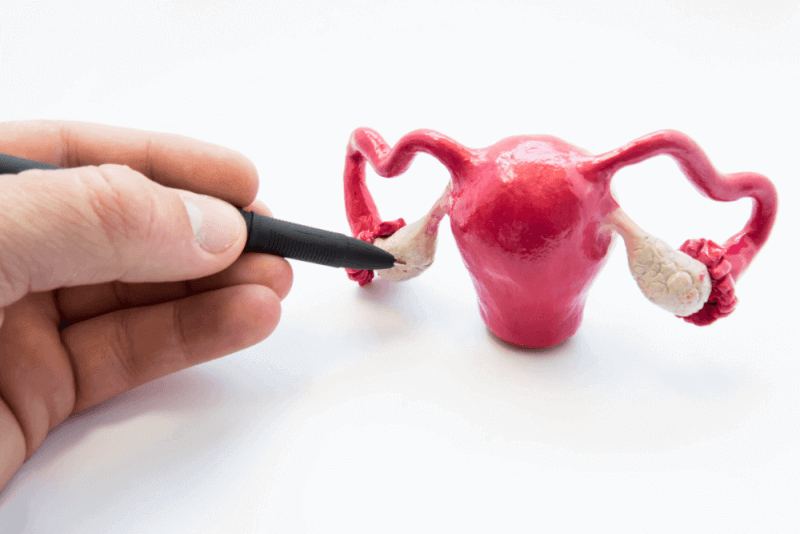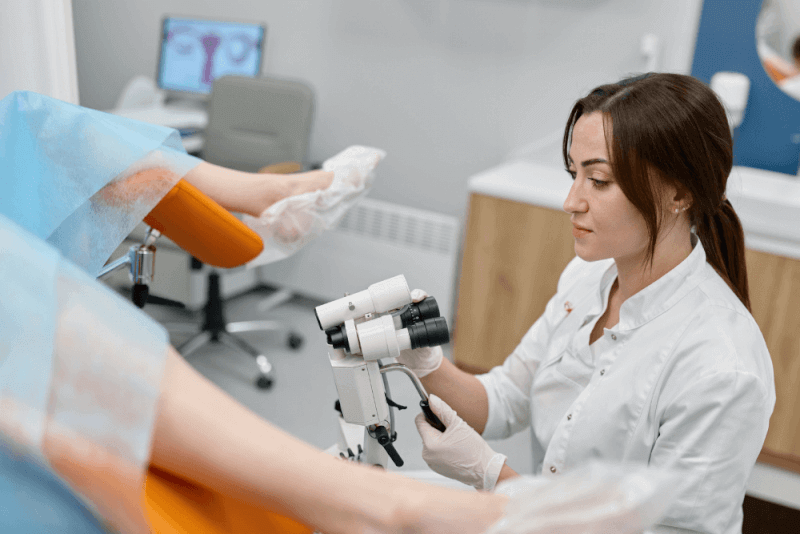What is an Ovarian Cyst?
An ovarian cyst is a sac filled with fluid or semi-solid material that can form on one or both ovaries. The ovaries are small organs in the pelvis that store egg cells and produce hormones like estrogen and progesterone.
Most ovarian cysts are painless and harmless. They often do not cause symptoms and are usually diagnosed during a routine pelvic exam or imaging procedure.
Although rare, ovarian cysts can cause various complications. Therefore, scheduling regular pelvic exams and discussing any symptoms with a doctor can help prevent potential issues.
Types of Ovarian Cysts
Most ovarian cysts are functional cysts. They form in response to changes in the body during the menstrual cycle. Less commonly, ovarian cysts can form for reasons unrelated to the menstrual cycle.
Functional Cysts
Functional cysts are the most common type of ovarian cyst and are not associated with disease. These cysts occur as a result of ovulation and can be a sign that the ovaries are functioning properly. Functional cysts typically shrink over time or within 60 days without special treatment.
Follicular Cysts
During the menstrual cycle, a small sac called a follicle releases an egg each month. A follicular cyst forms when the follicle does not release the egg. Instead, the follicle fills with fluid and enlarges.
Corpus Luteum Cysts
After the follicle releases an egg, a hormone-producing group of cells called the corpus luteum forms. A cyst forms when fluid accumulates in the corpus luteum and causes it to grow. Functional cysts are sometimes referred to as simple cysts.
Other Cysts
Not all ovarian cysts form in response to the menstrual cycle. These cysts are not always a sign of disease, but a doctor may want to monitor them to ensure they do not cause complications.
Cystadenomas
These cysts form on the surface of the ovary. They may be filled with a thin, watery fluid or a thicker, mucus-like substance.
Dermoid Cysts
Also known as teratomas, dermoid cysts can contain a variety of tissues, including skin, hair, teeth, and even brain tissue. These tissues originate from cells that can produce all types of body tissues.
Endometriomas
These cysts are filled with endometrial tissue, the same tissue that lines the uterus and bleeds each month during menstruation.
Ovarian Cancer
Unlike the conditions mentioned above, ovarian cancer cysts are solid masses of cancer cells.
Diagnosis of Ovarian Cysts
Before diagnosing an ovarian cyst, a specialist will first rule out pregnancy. The following tests are then used to diagnose an ovarian cyst:
- Pelvic examination: Specialists perform a pelvic exam to feel inside the pelvis for any swelling or changes.
- Ultrasound: Imaging of the internal organs can be obtained using ultrasound. This can help identify the location and nature of the cysts, such as whether they are primarily fluid-filled or solid.
- Laparoscopy: A procedure performed in the operating room that involves inserting a camera through an incision in the abdomen to visualize the reproductive organs and pelvic cavity.
- If a cyst is detected during the procedure, it can be removed.
Causes of Ovarian Cysts
Ovulation is one of the leading causes of ovarian cysts. Other factors contributing to the development of ovarian cysts include:
- Abnormal cell growth can lead to the formation of cysts such as dermoids.
- Endometriosis: Endometriosis cysts often develop on the ovary, particularly in the later stages of the condition.
- Severe pelvic infections can spread to the ovaries and cause cysts.
All women can develop ovarian cysts, but certain factors increase the risk:
- Women who have not yet reached menopause are more likely to develop ovarian cysts.
- The likelihood of developing an ovarian cyst increases during pregnancy, and these cysts are more likely to persist.
- Individuals who have previously developed ovarian cysts may experience recurrence.
- Various health conditions can increase the risk of ovarian cysts.
Symptoms of Ovarian Cysts
Some small cysts may not cause any symptoms, and many patients may be unaware of their presence. However, larger cysts can cause symptoms such as:
- Pelvic pain
- Dull ache in the lower back
- A feeling of fullness or bloating in the lower abdomen, sometimes more noticeable on one side
- Pain during intercourse
- Painful menstrual periods
Persistent symptoms may indicate a condition called polycystic ovary syndrome (PCOS), which can cause irregular periods and obesity. PCOS can also lead to other hormone-related issues, including infertility. Other symptoms of PCOS include increased body hair and difficulty losing weight.
Treatment Options for Ovarian Cysts
Treatment for ovarian cysts depends on the symptoms, age, and cause of the cyst. Treatment options include:
Watchful Waiting
Functional ovarian cysts usually disappear on their own without treatment. If the cyst is functional, doctors often recommend a watchful waiting approach. A follow-up ultrasound is performed a few weeks or months after the diagnosis to see if the cyst resolves on its own.
Medication
Hormonal medications, such as birth control pills, may be prescribed to stop ovulation and prevent the formation of future cysts.
Ovarian Cyst Surgery
Surgery is recommended to remove the cyst if it causes symptoms or continues to grow. The type of surgery depends on the size of the cyst and its appearance on ultrasound.
Risks of Ovarian Cyst Surgery
Ovarian cyst surgery is generally safe, but like any surgical procedure, it carries certain risks. Potential risks include:
- Infection
- Irritation at the incision site
- Injury to surrounding tissues, ovaries, or fallopian tubes
- Bleeding
- Allergic reaction to anesthesia
- Blood clot formation
- Recurrence of the cyst
- The need to remove one or both ovaries
The risk of complications increases if you have had previous surgery on pelvic organs or the abdomen. Other factors, such as smoking, diabetes, or obesity, can also increase the risk of complications.
Benefits of Ovarian Cyst Surgery
The primary benefit of ovarian cyst surgery is the removal of a potentially harmful or painful mass from the ovaries. Ovarian cysts, especially those that develop after menopause, can turn cancerous. Surgery also helps prevent complications like ruptured ovarian cysts or ovarian torsion.
Laparoscopic surgery is often preferred for ovarian cyst removal. This less invasive method allows for faster recovery. However, in some cases, an open abdominal cystectomy may be necessary. While invasive, the benefits of removing the ovarian cyst outweigh the risks of surgery.
Methods of Ovarian Cyst Surgery
Two different methods are used in ovarian cyst surgery. The first is laparoscopy. In laparoscopy, a camera and various surgical instruments are inserted through a small incision in the abdomen to remove the ovarian cysts.
The other method used in ovarian cyst surgery is laparotomy. This procedure is performed when the cyst is very large or when other concerns are present. If the doctor suspects cancer, referral to an oncology specialist or gynecologic oncologist may be necessary for treatment options.
Complications of Ovarian Cysts
Complications that may result from ovarian cysts include:
Cancerous Cyst
The likelihood of ovarian cysts turning cancerous is higher during menopause than before menopause.
Ruptured Ovarian Cyst
Ovarian cysts can rupture without causing any symptoms, but sometimes the rupture can lead to severe abdominal pain and swelling. The larger the cyst, the higher the risk of rupture.
Ovarian Torsion
In some cases, cysts can grow large enough to distort the shape of the ovary, increasing the risk of twisting. Torsion can cut off blood flow to the ovary, leading to tissue death. Severe pain, nausea, and vomiting are symptoms of ovarian torsion. If symptoms of ovarian cyst torsion are present, immediate medical attention is necessary.
Life After Ovarian Cyst Surgery
Recovery time after ovarian cyst surgery varies from person to person. Recovery time for laparoscopic cystectomy ranges from 1 to 3 weeks.
Patients can resume normal activities, such as returning to work, after 1 to 2 weeks. Physical exercise can also be resumed after this period. However, recovery may take up to 8 weeks if open cystectomy is performed.
The chance of becoming pregnant is not affected by ovarian cyst surgery. However, conditions that cause ovarian cysts may make it difficult to conceive. In addition, if the ovaries or fallopian tubes are damaged during surgery, fertility may be affected.
Recovery After Open Ovarian Cyst Surgery
Recovery after open ovarian cyst surgery takes longer, and the risk of complications is higher. To avoid complications during the recovery process, attention should be paid to the following points:
- Particular attention should be paid to the incision site after open ovarian cyst surgery. Keep the incision site clean and dry.
- There is no problem with taking a shower, but avoid touching the incision site with a sponge or similar material.
- If redness, swelling, or discharge occurs at the incision site, see a doctor as soon as possible.
- Short walks are recommended a few hours after surgery to reduce the risk of blood clots. Walking also speeds up blood circulation, which helps speed up the recovery process.
- Avoid sexual intercourse for about a month after open ovarian cyst surgery. Otherwise, there is an increased risk of infection, and the incision site may become strained. The doctor will inform the patient about the period during which sexual intercourse should be avoided.
Recovery After Ovarian Cyst Disease
After ovarian cyst surgery, patients are taken to the recovery room. Upon waking from anesthesia, patients may experience some discomfort due to the surgery. During this time, the medical team will continue to monitor vital signs such as blood pressure and heart rate.
If laparoscopic cystectomy is performed, the patient is usually discharged 2 to 3 hours after surgery. However, if open surgery is performed, an overnight stay in the hospital is required. Surgeons will provide patients with specific instructions to follow after surgery, including:
- When to take a shower
- How to care for the incision
- When to resume normal activities
- When the follow-up appointment is scheduled
- Medications for pain and discomfort
- What to expect during the recovery process, including the amount of vaginal bleeding
- When to resume sexual intercourse
- When to return to work
What to Watch Out For If You Have an Ovarian Cyst
If you experience any of the following symptoms, it is essential to see a doctor as soon as possible:
- Late, irregular, or painful menstrual periods
- Persistent abdominal pain
- Bloating and pain in the abdomen
- Difficulty urinating or emptying the bladder
- Pain during sexual intercourse
- A feeling of fullness, pressure, or discomfort in the abdomen
- Unexplained weight loss
- Feeling generally unwell
If you experience any of the following symptoms, seek medical attention immediately:
- Severe abdominal pain accompanied by vomiting or fever that comes on suddenly
- Dizziness and fainting or rapid breathing
- Cold, clammy skin
Symptoms of a Ruptured Ovarian Cyst
Ovarian cysts can rupture or tear. When this occurs, you may feel some pain. However, some people do not experience any pain. A few days after the rupture, some discomfort may begin to be felt.
Sometimes, when ovarian cysts rupture, spotting or bleeding similar to vaginal bleeding may occur. Symptoms of a ruptured ovarian cyst include:
- Sharp, sudden pain in the lower abdomen or pelvis
- Persistent bloating
- Abnormal spotting or bleeding
If a ruptured ovarian cyst is an emergency, the following symptoms may occur:
- Sudden and severe abdominal pain
- Pain accompanied by fever and vomiting
- Dizziness
- Weakness
- Fainting sensation
- Rapid breathing
If you experience symptoms of internal bleeding from a ruptured ovarian cyst, such as worsening abdominal pain or dizziness, call emergency services immediately. Surgery may be needed to control the bleeding.
How Are Ovarian Cysts Expelled During Menstruation?
Ovarian cysts can be expelled during menstruation. During ovulation, the cysts fill with blood. If pregnancy does not occur, the cyst is expelled along with the menstrual blood. These cysts help renew the body and do not cause harm. However, if the cysts are not expelled during menstruation, they continue to grow in the body.
Stress-Related Ovarian Cysts
Studies have shown that stress is one of the many factors that can cause ovarian cysts in women. Ovarian cysts are also associated with various psychological disorders, as they can affect hormone synthesis and secretion, potentially triggering psychological problems such as depression.
Ovarian Cysts During Menopause
It is generally believed that a woman's ovaries become inactive after menopause. However, while ovarian activity decreases, the ovaries do not become completely inactive. Therefore, they still have the capacity to produce cysts.
With the widespread availability of primary healthcare services and imaging methods, ovarian cysts are detected in approximately 12-17% of postmenopausal women. Most of these cysts are benign. However, due to the cancer risk associated with postmenopausal ovarian cysts, careful monitoring is recommended.
Ovarian Cysts and Sexuality
Reactions to sexual activity among individuals with ovarian cysts can vary. Most ovarian cysts are benign and very small, so they cause fewer complications. As a result, sexual intercourse generally does not affect these patients.
However, malignant cysts can cause various complications, and sexual intercourse can exacerbate tumor growth, so it is advisable to avoid sexual activity. The size of the cyst may cause pain, vaginal bleeding, bowel disorders, and burning sensations. These symptoms may worsen during sexual intercourse.
This can reduce the pleasure and excitement of the experience and negatively impact the quality of sexual intercourse. In cases where the tumor is very large, the force and pressure of sexual intercourse can cause the cyst to rupture. If a cyst ruptures, immediate medical attention is required. Otherwise, there is a risk of death. After ovarian cyst surgery, patients are advised to refrain from sexual activity for a certain period.








